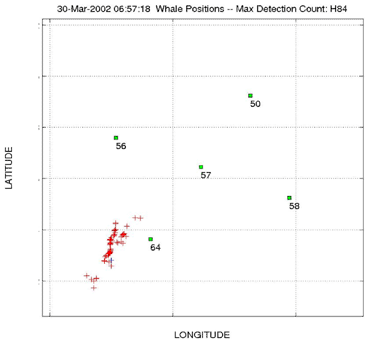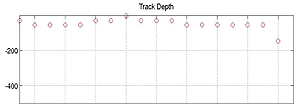M3R --
Marine Mammal Monitoring on Navy Ranges
A Novel Dual-Use for Navy
Undersea Range Facilities
The main objective of the Marine Mammal Monitoring on Navy Ranges (M3R)
project was to develop a toolset for passive detection, localization,
and tracking of marine mammals using existing Navy undersea range infrastructure.
The project was funded by the Office of Naval Research (ONR) as an effort
to provide an effective means of studying marine mammals in natural,
open ocean environments.
M3R has successfully developed and tested a suite of signal processing
tools that can automatically detect and track marine mammals in real-time
using Navy range facilities. The M3R toolset allows automated collection
of data previously unavailable for the long-term monitoring of the bioacoustic
behavior of marine mammal within their natural environment. This opportunity
has been created with minimal investment in infrastructure by utilizing
Navy undersea ranges as a dual-use asset. Research applications of the
M3R system include the ability to remotely estimate marine mammal abundance,
assessment of bioacoustic behavioral baselines, and evaluation of the
impacts of anthropogenic noise by comparison to those baselines.
 |
|
Located around the world, the Navy’s fixed undersea ranges have several hundred deployed hydrophones in diverse environments. When coupled with the M3R toolset, these hydrophones represent "sensors of opportunity" for the study of marine bioacoustics in open ocean environments.
 |
| Ideally located in the Tongue of the Ocean, AUTEC served as a test bed for the M3R toolset during March and April 2002. Over 500 sq. Nmi of open ocean were automatically monitored using passive acoustics. The movements of several species of odontocetes were successfully tracked in three dimensions. |
The M3R toolset is also compatible with portable and deployable tracking systems. Using deployable tracking systems, bioacoustic characterization of specific habitats could be conducted. The M3R toolset could also be extended to the detection and localization of soniforous fish populations. Such localization could be useful to fisheries biologists and for fisheries management.
| Deployable tracking systems, which use acoustic sensors deployed from sonobuoys or autonomous station keeping buoys (left), could bring M3R detection and tracking capabilities to specific habitats of interest. |
For more information contact: David Moretti, M3R Principal Investigator, Code 70T, Naval Undersea Warfare Center Division Newport, RI 02841. Ph: (401)832-5749, E-mail: morettiDJ@npt.nuwc.navy.mil. The M3R project was sponsored by the Office of Naval Research, Dr. Robert Gisiner, Principle Investigator for the Marine Mammal S&T Program, E-mail: gisiner@onr.navy.mil.
